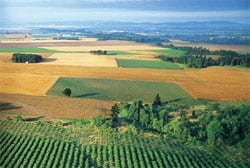By Patricia Black, MPP 2014

Across California, low-income communities experience restricted access to essential natural resources and public services. Nowhere in the state is this more apparent or devastating than in California’s San Joaquin Valley. Residents in areas like Bakersfield, Delano, Fresno, and the more rural areas of San Joaquin Valley face unprecedented poverty and unemployment rates, limited employment opportunities and underfunded education options. Fresno has the second highest poverty rate in the nation, while Bakersfield and Delano rank as numbers four and five. In 2013, the poverty rate in Kern County, which has both Bakersfield and Delano within its borders, was 22.5%. [1] The state average is 16.6%.[2]
Poverty rates correlate with access to essential resources, like clean water and affordable gas and electricity transmission. Significant water contamination affects the drinking water of 1,000,000 San Joaquin Valley residents, although if nitrate contamination were included, the number would increase to over 2,000,000 people, roughly half of the region’s population.[3] Furthermore, air quality is poor and access to cleaner burning fuels for residential and corporate needs is low.
In urban areas, access to cleaner burning and less expensive natural gas for heating and cooking in homes is readily available through municipal utility services and the low monetary cost of natural gas reduces utility bills for residents. Unlike residents in urban areas, residents in the San Joaquin Valley, the poorest region in the state, are unable to receive natural gas transmission because the infrastructure has not been built to do so. As evidenced in New York State, residents may live as close as 100 feet or less to an existing transmission line, but are unable to utilize the resource because their municipal utility service cannot afford to pay for transmission line improvements.[4] That this infrastructure, which has been in place for decades in more urban, wealthier communities throughout California, does not exist in the state’s most compromised and struggling communities is detrimental to the livelihood and sustainability of the region. As is the case throughout the Central Valley, poor communities suffer as a result of neglect and blatant disregard for the needs of impoverished, rural areas.
State and local legislators have done little to address the needs of Central Valley communities and have not attempted to rectify the problem. As the wealthiest state in the country, it is the responsibility of residents to demand equal access to resources for all communities. This has not been done.
Less than one month ago, the State Assembly passed a bill funding a program to research how many California residents cannot access natural gas, and requires utility companies address inequities in service provision.[5] With no clear guidelines or recommendations for how to improve access to natural gas, the bill does little to address the problem, and leaves communities in the same predicament they were in before the bill was passed: un-empowered, underserved, and paying higher premiums as a direct result of poverty.
[1] US Census, 2013
[2] Public Policy Institute, 2013
[3] Environmental Protection Agency, 2013
[4] NY State Senate, 2013
[5] CA Assembly Bill 2672, 2014
A goal of The Policy Forum is to promote a respectful discourse around the issues raised by our featured authors. We expect all comments to be constructive and relevant. As a courtesy to our users: the public, your colleagues, and our staff, we reserve the right to moderate comments to ensure the professional atmosphere of this academic journal.